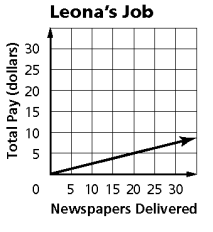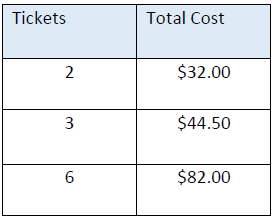WRITE A LINEAR MODEL FROM WORD PROBLEM WORKSHEET
1) The function below shows the cost of a hamburger with different numbers of toppings (t).
f(t) = 1.90 + 1.40t
a) What is the y-intercept, and what does it mean?
b) What is the slope, and what does it mean?
c) If Jodi paid $3.30 for a hamburger, how many toppings were on Jodi’s hamburger?
2) The function below shows the cost of an ice cream sundae with different numbers of toppings (t).
f(t) = 2.25 + 0.75t
a) What is the y-intercept, and what does it mean?
b) What is the slope, and what does it mean?
3) The graph below shows the number of newspapers delivered and total pay for Leona’ newspaper delivery job. What does the slope ?

4) Dionne pays a fixed fee plus an hourly rate to rent a boat. The table below shows how much Dionne paid for the boat. What was Dionne’s hourly rate to rent the boat?

5) Colby put $100 in a savings account. The graph below shows how the amount in the account would increase over the next ten years. What does the y-intercept represent?

6) Tara pays a base rate for her long distance phone service plus a per-minute charge. The graph below shows what she would pay for her long distance phone service for the first 60 minutes. What does the y-intercept of this graph represent?

7) Rich is a member of a gym. He pays a monthly fee plus a per-visit fee. The equation below represents the monthly amount Rich pays for his membership to the gym per month for x visits.
y = 3x + 10
What does the y-intercept of the graph of this equation represent? Solution
Answer Key
1) a) cost of hamburger is $1.90
b) Here the meaning of slope is how the charge is being affected for every increase of one topping.
c) there is one topping.
2)
a) When there is no topping, the cost of ice cream sundae is $2.25.
b) For every one increase of topping, we have to pay 0.75 more.
3) m = 1/4
4) hourly rate is $12.
5) the amount in savings account is $100.
6) The base rate is $5.
7) membership of the gym is $10 and per visit he has to pay $3.
Write an equation, in slope-intercept form, to model each situation.
Problem 1 :
You rent a bicycle for $20 plus $2 per hour.
Problem 2 :
In 1995, Orlando, Florida, was about 175,000. At that time, the population was growing at a rate of about 2000 per year. Write an equation, in slope-intercept form to find Orlando’s population for any year
a) Predict what Orlando’s population will be in 2010
Problem 3 :
Couples are marrying later. The median age of men who tied the knot for the first time in 1970 was 23.2. In 1998, the median age was 26.7. Write an equation, in slope intercept form to predict the median age that men marry M for any year t.
Use the to predict the median age of men who marry for the first time in 2005.
Problem 4 :
Carmela is a member of a social club. She pays an annual membership fee and $15 for each event she attends. The equation y = 15x + 25 represents her total cost each year. Which statement(s) about the function is true?
(Hint: three of these are true)
A. The initial value is 15.
B. x represents the cost of each event.
C. The rate of change is 15.
D. The initial value represents the annual membership fee.
E. The number of events she attends is a function of the total cost.
F. The total cost is a function of the number of events she attends.
Problem 5 :
Vinh pays a convenience fee when he reserves movie ticket son his cell phone app. The app shows him the total cost of his purchase for different number of tickets in the table shown.
a) What is the equation that models this linear function? Show your work.

b) How much is each movie ticket? Solution
Problem 6 :
You and your friend are riding bicycles down the same road at different constant speeds. After 3 minutes, you are 60 feet ahead of your friend. After 5 minutes, you are 100 feet ahead of your friend.
a. Write an equation that represents the distance y (in feet) you are ahead of your friend after x minutes.
b. How far ahead will you be after 10 minutes?
Problem 7 :
You are knitting a blanket at a rate of 4 inches per day. After 4 days, you have knitted 16 inches.
a. Write an equation that represents the number of inches y you have knitted after x days.
b. How many inches will you have knitted after 7 days?
c. Will you have knitted 100 inches after 30 days?
Answer Key
1) y = 2x + 20
2) y = 205, 000
3) the median age is 27.57 at 2005.
4) A) False
B) True
C) True
D) True
E) False
F) FAlse
5) a) y = 12.5x + 7.
b) y = 19.5
6) a) y = 20x
b) y = 200 feet
7) a) y = 4x
b) after 30 days blanket can be knited for more than 100 inches. Then it is yes.
Recent Articles
-
Finding Range of Values Inequality Problems
May 21, 24 08:51 PM
Finding Range of Values Inequality Problems -
Solving Two Step Inequality Word Problems
May 21, 24 08:51 AM
Solving Two Step Inequality Word Problems -
Exponential Function Context and Data Modeling
May 20, 24 10:45 PM
Exponential Function Context and Data Modeling